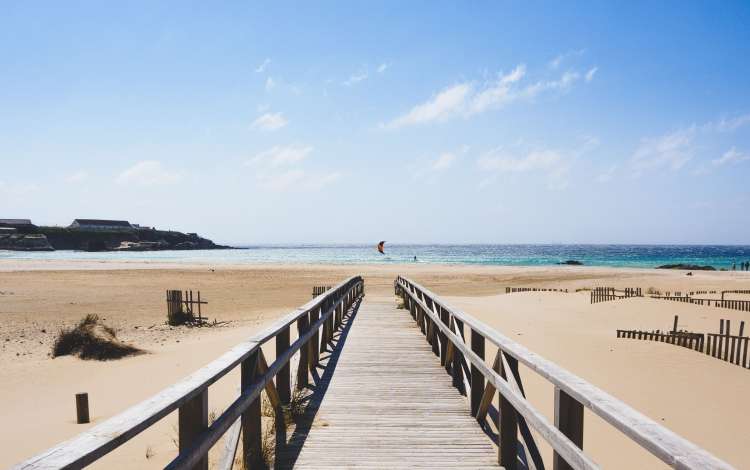Follow Arcadia around the world
Explore more on Destinations

If you’re looking for a holiday that combines some of Europe’s most exhilarating cities with copious sunshine, cultural clout and fabulous food, it’s time to head west down Spain and Portugal’s Atlantic coast.

A lively place to start a day immersed in the spirit of Cádiz is at the central market. Not only a hub of early morning activity, it’s also the place for a tasty breakfast of fresh, crispy churros and hot chocolate for dipping at one of the city’s most famous spots, Churrería El Puesto de Ana. Then head out to discover some of the secrets of this urban peninsula. As you stroll across elegant plazas and past time-weathered mansions, a view of the sea or the gentle crescent of La Caleta beach is never far away. It’s like exploring an island city.
And you can’t escape the influence of flamenco. Cádiz is its birthplace and many of the greatest singers, dancers and musicians of this Andalusian artform are from the region. For the chance to see live flamenco with a memorable lunch, visit Taberna El Marques de Cádiz. Decorated with photography and memorabilia, this authentic 18th-century tavern is evocative of traditional flamenco gatherings.

Since the ultra-modern Frank Gehry-designed Guggenheim Museum opened in the late 1990s, Bilbao’s grown into a hotspot for art and design lovers. On the Abando bank of the river Nervión, the Guggenheim is a must, even if you don’t venture inside. Elsewhere in Abando, check out Philippe Stark’s funky Azkuna Zentroa cultural centre. Once a wine warehouse, it’s now a hub of all things cool. You should also take time to potter in the lovely Museo de Bellas Artes, which houses works dating from the 12th century through to pieces by Cézanne and Gauguin.
Across the river, explore Bilbao’s more traditional architecture in Casco Viejo. Don’t miss the elegant Plaza Nueva, the Gothic Catedral de Santiago and Las Siete Calles, the original seven streets of Bilbao that date back to the 1400s. This is a great area to sample the city’s famous pintxos, Basque tapas. Another foodie haven is historic Mercado de la Ribera where you can immerse yourself in the delights of Basque produce.

La Coruña exudes understated charm with a hearty dose of natural beauty. To really get a feel for the city, wander around the pretty old town, filled with cobbled streets and little squares radiating off the central square of Azcárraga. The Calle de la Franja is a gourmet’s heaven, especially restaurants Mesón do Pulpo (no 9) and O Xestal (no 38). If you’re looking for souvenirs, seed packets of the region’s most famous veggie dish, Padrón peppers, make nice gifts, as does a bottle of the delicious local albariño wine, or domed queso de tetilla; find them at the old-school delicatessens of the Ensanche district or the stalls of the central market.
To experience its ethereal beauty of Galicia, head out of town. A few miles east of La Coruña is the sheltered coast around Sada, while heading west towards Arteixo, huge Atlantic rollers batter the brooding Rías Altas coastline. Along the way, densely forested inlets echo Norway rather than Spain, especially if you cross the Fornelos Hanging Bridge over the Eume River into Fragas do Eume nature park.

If you’re visiting Porto (from Leixoes), Mercado do Bolhão is a must-see: an architectural and foodie gem located slap bang in the middle of the city. It’s the perfect place to try local specialities and taste and discover the ingredients that Portuguese chefs and home cooks use each day. Most of the vendors have worked here for decades and their warmth has become famous throughout Portugal. It’s a great spot for a lazy lunch. The informal café restaurants that run along the centre of the ground floor source their ingredients from the stalls, making everything fresh and seasonal. Choose a sun-dappled table, sip a local wine and, as you wait for your meal, watch Porto’s local life unfold around you.

Northern Portugal may be the country’s culinary heart but Lisbon is home to Portugal’s most famous pastry: the creamy, sweet and utterly delicious custard tart, the pastel de nata. Best eaten sprinkled with cinnamon and with a strong coffee or a small glass of port on the side, you can’t escape these golden sweet treats.
Every pasteleira (cake shop) has its own version so it’s a question of trying and tasting. However, the best-known and most popular are those made by Pastéis de Belém. The company’s been making pastel de nata to its own secret recipe since 1837 and they make 20,000 a day to meet demand. It doesn’t sell its them anywhere else so if you want to try one, you’ll need to make a trip to Belem and stand in the queue with hungry locals. Alternatively, find a table in the restaurant: its terracotta floors and blue and white tiled walls are almost as Portuguese as the cakes it serves.

of
Don’t miss out! Sign up for latest news, offers and competitions from P&O Cruises.